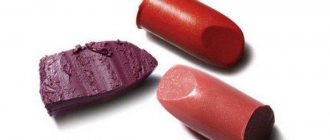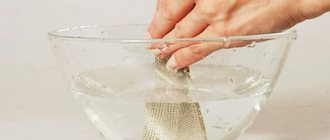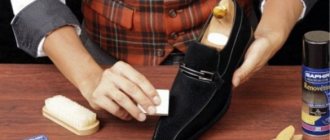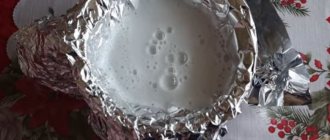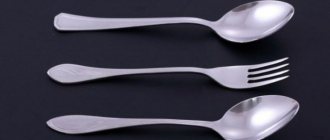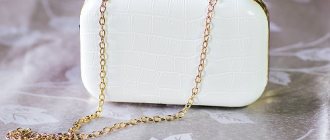Hello friends.
Silver is a common, versatile material used by jewelers to make jewelry. Unfortunately, compared to other metals, it is quite fragile and tends to tarnish. The delicacy of silver may discourage the owner from cleaning it themselves.
However, you don't need to be that professional to complete this task. Today I will tell you how to clean a silver cross, I will give you several common methods that have been proven over the years so that you can choose the most suitable one.
Types and causes of contamination of the cross
Damage, evil eye, loss of strength, curse... All this is attributed to a darkened silver cross. I won't argue. Let everyone believe what they want. I'll come from the other side. A silver cross can oxidize under the influence of sulfur, its derivatives and chlorine.
Over time, a patina appears on the cross - a coating that gradually darkens, turning into black. Sulfur compounds are released into the air from the combustion of gasoline and coal. Chlorine is often added to water to disinfect it. That, in fact, is all the curses are.
Useful tips
When choosing means to effectively clean the surface of silver amulets, it is necessary to take into account the structure and composition of the source material. When it comes to matte surfaces, then special care should be taken when taking preventive actions. After all, the external resistance of the rough layer increases significantly.
In addition, in some cases, crucifixes on crosses are distinguished by filigree precision, conveying in detail the 3D structure of the frescoes. It is important to consider here that the effects on the outer surface of the image should not be linear.
Cleaning methods
There are two of them: entrust the work to a professional or clean it at home. The first method is attractive because everything will be done at the highest level. The jeweler will not only clean your silver cross and chain, he will polish it to remove scratches.
The trouble is that you have to pay for it. And if this approach does not suit you and you want to clean the silver jewelry yourself, then let’s move on to other methods.
Home methods
So we got to the most important thing. “Mix chalk, ammonia, alcohol in clean water. Put a silver object in there for 20 minutes and take it out clean,” The Times of London responded in September 1869 to a reader’s question about how to clean silverware. I will not insist on testing this old-fashioned method, since there are others.
Baking soda
Patina can be cleaned using a chemical reaction: the interaction of silver, soda and aluminum. Boil water in an aluminum pan. Add soda at the rate of ¼ cup of powder per 1 liter of water. Place a silver cross into the solution and wait a few minutes.
Rinse the item. If necessary, clean the relief of the design with a brush and wipe dry. If the silver cross does not turn white, the procedure should be repeated. If you don’t have an aluminum pan, you can use food foil to line the bottom of any container. Or move on to the next method.
Vinegar
Another great way to clean your silver cross is to soak it in a solution of white vinegar and salt. Acetic acid with sodium chloride leads to a chemical reaction that dissolves copper oxides.
Some people add a few more drops of tea tree oil and leave the jewelry to soak for several hours. In this case, in addition to purity, silver supposedly acquires strong antibacterial properties.
Toothpaste
Our grandmothers also used this method. True, instead of paste they used chalk. The principle of working with a silver cross is no different from brushing your teeth. Take the paste, brush, water and start rubbing. Abrasive substances will easily clean the jewelry, remove patina film and dirt. By the way, treatment with the same soda will lead to a similar effect. The main thing here is not to overdo it.
Ammonia
An excellent product to clean a silver cross. Many industrial treatments include ammonia. Ammonium hydroxide is an alkaline product. Like lye, it is able to combine with fats and oils, turning them into soap, which in turn is easily washed off with water.
Pour 50 ml of ammonia and 100 ml of water into a glass. Dip the silver cross into the solution for a few minutes, then rinse thoroughly. To improve the effect, you can add liquid soap. It is advisable to use a protective mask, since ammonia is an extremely odorous substance.
Hydrogen peroxide and alcohol
Rubbing (isopropyl) alcohol and hydrogen peroxide are excellent antiseptics and disinfectants. Despite their similarity, they should be used separately and with great caution.
Pour 91% isopropyl alcohol into a container and place a silver cross there for 8 hours. Then wipe the cleaned jewelry with a soft cloth, removing visible dirt.
Hydrogen peroxide is used not only for medical purposes. It is known as a bleaching agent and stain remover. Carefully apply the liquid to a swab or napkin and clean the jewelry, getting rid of blackness and dirt.
If you have a chain made of a similar alloy, it is better to clean it first. You should evaluate how the metal reacts to peroxide, whether it will begin to blacken even more.
Lemon acid
Perhaps the easiest and most inexpensive way to clean the blackness from a silver cross. The main advantage is that citric acid has a greater effect on oxides without affecting the base metal. Dilute 30 g of food acid in a glass of hot water and place a silver cross there. After some time, the decoration will begin to shine.
You can also use natural juice by squeezing it onto the blackened object. By the way, citric acid perfectly removes any rust. Housewives often use it to clean cutlery and remove scale from washing machines, dishwashers, and kitchen utensils.
Pepsi and Coca-Cola
The girl put a tablespoon into the container with Coca-Cola and took out a dessert spoon. Jokes aside, these drinks are so aggressive that they dissolve everything they come into contact with. They will also be able to clean the dirt from our silver cross. True, it will take quite a lot of time. I don't really recommend this method, but you can try it.
As a small digression. In addition to using these drinks for their intended purpose, the inquisitive human mind has come up with a use for them in other areas: you can, for example, clean the toilet and sink with them. They serve as a stain remover, clean glass, and repel insects. Can be used as a pain reliever, deicer, pesticide...
Salt
Given the similarity of the chemical composition, tarnished silver can be cleaned using salt and food foil. Check out the baking soda cleaning method and replace it with salt. The result will not be as pronounced because the soda is more aggressive.
Paste GOI
A special abrasive composition used for grinding hard surfaces. The paste should be applied to a soft cloth and our silver cross should be cleaned with it. And again, the main thing is not to overdo it. In the army, belt plaques are cleaned with GOI paste. After a year or two of such manipulations, the star, anchor or coat of arms is erased almost to the ground.
Special means
All of the above remedies are effective to a greater or lesser extent. However, progress does not stand still. We have long forgotten how to rinse clothes in a river, scrub a pan with sand, and extract lye using it instead of soap. So why not simple and cheap jewelry cosmetics appear, replacing “grandmother’s” methods? And, of course, she is.
"Aladdin"
The brainchild of ZAO PO Ruta, Aladdin is a whole line of professional jewelry cleaning products. Each metal has its own composition. Including for silver. Cleaning looks like this: silver jewelry is immersed in a jar of solution using a special bath for 20–30 seconds. Heavy dirt can be cleaned with the brush included in the kit.
With the help of this drug, your silver cross will instantly lose all darkening. The only thing is that the color will be matte. To add shine, polish the cleaned item with a soft cloth.
The manufacturer does not disclose much about the composition of the product. Water, surfactant mixture, phosphates, organic solvents, fragrance. The cost is quite affordable: from 70 to 95 rubles per jar. You can order through online stores or search in chemistry departments.
"Mascot"
A super effective product for cleaning silver at home. So, in any case, says St. Petersburg. Sold in various volumes: from 50 ml (for 125 rubles) and above. Composition: nonionic active substance, thiocarbamide, inorganic acid, water.
Baths are not included, it is recommended to use glassware. The principle is the same: pour the solution, place a silver object in it, then clean it with a soft flannel, rinse and dry.
Reviews are different. Some people really like it, others curse and spit. As far as I understand, the latter have not very high-quality silver. The jewelry simply turns yellow, even though it is stamped with a high standard. Not suitable for products with natural stones.
Unicum
The B&B plant located near Moscow is focused on the production of modern household chemicals. The product for cleaning products made of precious and non-ferrous metals is currently produced in a single copy. A 380 ml plastic bottle will last a long time.
Directions for use: Squeeze the cream onto a damp sponge or napkin and apply to a contaminated metal product. After a few minutes, rinse off and you're done. For polishing, use it without water.
Ingredients: calcium carbonate, non-ionic active substance, Trilon B, thickener, preservative, water. Cost – from 128 rubles. The reviews are mostly positive. You can clean a silver cross without any problems.
Recommendations for caring for a pectoral cross
Tips to help maintain the attractiveness of silver jewelry:
- It is not recommended to take a shower, play sports, or apply cosmetics without removing the pectoral cross;
- every month it is necessary to clean the product from dirt using a soap solution, leave the decoration for 1 hour, after which you can rinse it;
- As complex contaminants appear, including blackness, more complex cleaning methods are used.
How to clean silver with stones
The question is that different minerals require an individual approach. Precious stones are generally very sensitive to chemicals, which is why such jewelry is removed before washing dishes or cleaning the house.
The general recommendation is this: to avoid severe contamination of the jewelry, regularly clean it in soft water and soapy water.
If you do not plan to wear your silver jewelry constantly, then store it properly. The best way is to put them in individual sealed bags. Then there will be no conditions for the formation of patina. And the stone will remain clean.
Rhodium plated silver
Rhodium is a noble metal of the platinum group. It is usually used to coat jewelry, giving it a steel-white color. White gold, for example, always undergoes a rhodium plating procedure. It is often applied to silver.
A silver cross coated with a rhodium film will receive complete protection from aggressive environments and, therefore, will not darken. It is enough to wash it in a soapy solution to remove settled dust and dirt.
The disadvantage is that over time the protective layer wears off and requires renewal. And this is expensive. Thus, decorative rhodium plating of one piece of jewelry will cost from 500 rubles, and restoration from 1000.
Gilt silver
It should be treated more carefully. Gilding makes the silver cross look richer, while at the same time protecting it from the formation of a dark film. However, the coating is so thin and gold is such a soft metal that abrasion is inevitable. And jewelry cleaned with harsh methods will lose its gilding even faster.
To clean a gold plated cross, use a mild soap solution, warm water and a soft flannel. After allowing the jewelry to soak a little in the soapy solution, it should be rinsed under running water, cleaned with a cloth, and dried.
Hard-to-reach places can be cleaned with a toothbrush. To restore shine, use a special polishing cloth. Under no circumstances should abrasive materials be used.
How to save the result
To do this, follow the recommendations for caring for silver:
- Store the cross only in a box and in a room without high humidity.
- Do not place products containing sulfur nearby.
- Use only proven cleaning methods.
- Be sure to remove the silver cross before intense physical activity.
- Do not allow the cross to interact with cosmetics.
- After the product gets wet, be sure to rinse it with clean water and dry with a napkin.
Taking good care of your silver cross will allow you to preserve its purity, shine and beauty for a long time.
Jeweler's cleaning tips
- Use special fabrics.
To polish your silver jewelry, use a special polishing cloth. You can use a thin diaper, but professional materials will lead to better results. Paper towels or napkins may cause scratches.
- Be careful.
Regular cleaning will help keep your jewelry in good condition, but be careful. Buy special cleaning products from jewelry shops or prepare them yourself. Ammonia works wonders, but bleach will literally destroy the cross. Avoid him at all costs.
- Use warm water.
Warm water is best to clean your jewelry. However, it can also provoke an undesirable reaction with washing liquids, causing discoloration. Silver is especially sensitive to this. In this case, the problem can be solved by polishing using special cleaners.
- Avoid cleaning damaged jewelry.
Never clean jewelry that has mechanical damage. This can make the problem significantly worse. Set the cross aside for repair in a specialized workshop.
Prohibited tricks
Regardless of the composition or coating methods of silver crosses, cleaning methods that involve deep penetration should be avoided. These include:
- caustic chemical compounds;
- hard bristle brushes;
- or abrasive powders.
Even the smallest scratch on a glossy surface will be an insurmountable obstacle the next time you clean it. As a result, such damage can only be repaired in a workshop with professional equipment.
Rules for wearing, caring for and storing silver crosses
To keep your cross in attractive condition longer, use these simple tips:
- remove jewelry before swimming. Soap can cause a patina to form, which will not add to the beauty of your decoration;
- Tanning products may contain chemicals that can damage your silver cross or chain. Avoid contact with them;
- Do not wear jewelry in saunas, swimming pools and spas. Temperature and chlorinated water will inevitably cause discoloration;
- When playing sports, make sure that the chain and silver cross will not interfere with you. This is especially true for all types of martial arts;
- If you do not wear your silver cross for some time, then store it in a specially designated dark place. It is best to place in a sealed plastic bag to prevent air from entering;
- Do not store silver jewelry together with items made from other metals. This may cause tarnish;
- Keep the gold plated cross away from hard surfaces to avoid bumps and scratches. It is best to wrap it in a soft cloth.
Why does the cross lose its shine?
Silver is the most common material for making pectoral crosses. On the one hand, it is a noble metal with its inherent aesthetic and physical properties, on the other hand, silver is not as expensive and pretentious as gold.
Like any noble metal, silver is quite resistant to aggressive chemical factors, but over time it also loses its presentable appearance: it turns black, turns green, becomes covered with scratches, and so on.
Silver pendant with alpanite and enamel (go to the SUNLIGHT catalog)
Among the most common reasons for a silver cross losing its original appearance, it is worth mentioning the impact of:
- Sunlight and warmth. The silver-based jewelry alloy used to make cross necklaces may be sensitive to sunlight and extreme heat. Conclusion - you need to wear the cross correctly, under your clothes, exposing it to the sun only in the summer on the beach.
- Water and chemicals. A change in the color of silver can be caused by exposure to water and various reagents, including soap, shower gel, skincare cosmetics and household chemicals that accidentally come into contact with the jewelry.
- Secretions of the human body. We mention this factor at the end of the list only to attract attention, because in fact, sebum, sweat and other natural body secretions have the most detrimental effect on silver (fortunately, reversible). They contain sulfur, which reacts with silver and copper contained in most jewelry alloys. The sulfide formed as a result of the reaction is the dark coating that often covers silver items.
The more alloys (additives) in a jewelry alloy, the sooner the silver loses its original shine. Therefore, it is wise to choose crosses made from 960, 925 or 875 sterling silver. You shouldn't save money at this point!
Preparing the product for cleaning
Fortunately, you can clean a silver cross on your own, using quite affordable means that are likely to be found in the arsenal of every self-respecting housewife.
First, you should first prepare the product for cleaning:
- Remove the cross from the chain. If the cross hangs on a chain, you should remove it, but manipulations are allowed with both elements of the decoration. The gaitan cord, of course, will not withstand such treatment, so it must be processed separately.
- Soak the decoration in soapy water. We prepare a soap solution based on laundry soap, shower gel, dishwashing liquid, and so on. You can select the proportions yourself, because you can’t really harm the silver with such means, but the solution should really lather well.
- We wash off the main contaminants. After the cross and chain have thoroughly soaked (after 20-40 minutes), you can treat them with a sponge or a very delicate toothbrush, removing the main contaminants.
- Rinse under running water. Wash the decoration elements simply under the tap. But if you are afraid of losing them down the drain, you can fill any container with cool water and use it to wash off the remaining dirt and soap solution from the cross.
- We carefully dry the decoration. Dry silver items carefully, naturally, carefully removing water with a soft cloth or flannel cloth. No high temperatures or blowing with a hairdryer!
If the contamination is very large, you can resort to professional cleaning. Jewelry workshops have special devices for ultrasonic cleaning of jewelry.
Hydrogen peroxide
Hydrogen peroxide also cleans silver well, but its use can lead to unexpected results. The fact is that the substance can both oxidize and reduce compounds. In one case, when using peroxide, you will get a brightened product, in another - jewelry with plaque or stains. It all depends on the amount of impurities in the silver product. You can clean silver from blackness using peroxide with the addition of ammonia, but even in this case you need to act with extreme caution. It would be best to test the product on a small area of the product; if it becomes lighter, the procedure can be continued.
Cleaning blackened silver at home
Blackened silver is rarely found in jewelry stores, but it is plentiful at flea markets and in grandma's chests. A touch of antiquity will give the product nobility, but a touch of dirt and dust - not so much. You can clean black silver with soda and salt and a cleaning agent, a regular school eraser, or ammonia with crushed chalk. There is no guarantee that the product will regain its original shine, but it will look much fresher and cleaner.
Reasons for darkening of silver items
There is a belief: if a silver cross on a body cross turns black, it means that it has taken on a negative or even an evil eye directed at its owner.
Causes:
- You often swim in the pool without taking off your jewelry. The interaction of silver with chlorinated water causes the metal to tarnish and black spots to form on it.
- The cross turns black when it comes into contact with cosmetics and perfumes (cream, body lotion, perfume).
- Human sweat also negatively affects silver items.
- Silver can darken even without prolonged use, especially when several pieces of jewelry are stored together in one box.
Impurities
If a silver cross often turns black and becomes dull just a few days after cleaning, most likely the product is not made of pure silver, but contains an admixture of cheap metals.
As mentioned above, you need to clean a silver chain and cross with extreme caution. If you are careless, you can damage the outer layer of the coating. There are a few other features you should be aware of:
- When it comes to cleaning silver, this is all about silver. You should not take risks and combine the purification of gold and silver. These are two completely different alloys requiring an individual approach. To prevent them from reacting with each other, it is better to wash them separately, even using the same method.
- Hydrogen peroxide does not react with silver, but at the same time it is able to react with other impurities that are in the alloy. Therefore, this remedy is considered risky and can ruin the appearance.
- Cleaning with abrasive substances is unacceptable for this alloy and is used only in the most extreme cases when there is no other option.
- For wiping, use flannel, napkins and soft cloth. At the same time, you need to wipe it dry so as not to leave moisture on the surface. Otherwise, the darkening may return in a short time.
If the silver cross has darkened, it can always be cleaned using one of the methods given above. Remember the precautions to avoid damaging the product. Are you afraid of harm? It’s better to take it to a workshop, where the procedure will be done by experienced professionals following all the rules.
Argentum, the Russian name for silver, is a unique element. It does not oxidize in water, but rather purifies it. Due to its plasticity and flexibility in processing, the precious metal has gained popularity among jewelers. Folk legends endow silver with mystical properties. It is believed that a white metal amulet can protect the owner from the machinations of dark forces.
As a chemical element, silver reacts with nitric, sulfuric, hydrochloric acid and other substances. If the contact with the reagent was short, then the silver is covered with a thin film of silver chloride, which quickly darkens when exposed to sunlight. However, this is not the only reason for changes in the color of precious metal products.
The silver cross and chain may turn black under the following circumstances:
- Excessive sweating during physical activity or illness
- High air humidity
- Contact with hydrogen sulfide in everyday life (sewage, garbage disposal)
- Exposure to detergents and cosmetics
- Contact with medical iodine and iodine-containing products
- The presence of impurities of other metals in the product (determined by the silver standard)
There is a version that the cross turns black, reflecting a negative impact on a person; sometimes no other justification can be found.
On a note!
Silver quickly conducts heat and heats up, so if exposed to direct sunlight, it can leave a thermal burn on the skin. Silver jewelry lovers should keep this in mind.
To prevent silver items from blackening, they must be monitored and cared for. Preventive measures consist of simple rules:
- Once every two weeks, silver jewelry that is constantly worn on the body should be washed with soapy water without alkalis (baby soap is ideal).
- Before taking a bath, a hygienic shower, or visiting a sauna or Russian bath, the chain and cross must be removed.
- Silver products should be stored in closed boxes, first wrapped in cloth without synthetic fibers.
If a silver cross turns black, despite following all the rules, perhaps negative energies are really aimed at its owner. This is not a reason to run to psychics, but a chance to think about who and why might wish evil. In such cases, the Orthodox are protected by the Sorokoust prayer service and the consecration of the cross in the church.
If the cross has turned black, and even the chain has broken, there is no need to panic; most likely, higher powers are warning about upcoming changes. Don’t be afraid of them, everything that happens is for the better!
Share the article on social media. networks:
Ammonia
0
Source:
Another way to restore your jewelry to its former shine is to wash the silver with a solution of ammonia and water. Ammonia is considered an excellent solvent; it will help to better clean silver from plaque or dirt without damaging the product itself. Pour water into a small container, add ammonia in a ratio of 1 to 10, put in the decorations and leave them for 30 minutes. If after half an hour it was not possible to return the shine to silver, you need to keep it longer in the solution. After the procedure, all that remains is to wipe the rings, chains or bracelet dry. Cleaning silver with ammonia at home is very simple and quick.
Why does silver tarnish
There is an opinion among the population that the blackening of silver jewelry is associated with negative energy that the metal absorbs. That is, the more often the owner of the item catches the eye of envious people, the more blackness becomes on the surface of the silver. In fact, there are several other reasons that entail blackening, and all of them have nothing to do with mysticism.
- Increased air humidity, which enters into chemical processes with the metal and makes it noticeably duller.
- Storing silver next to a home medicine cabinet or medical preparations containing sulfur.
- Features of the skin of the owner of the product, as well as excessive use of perfume or skin care products.
Cleaning with foil and baking soda
0
Source:
You can clean silver using baking soda and foil in a few minutes. This recipe is considered one of the fastest and most effective. First of all, you need to boil water, add soda to it (50 g/1 liter of water). After boiling, pour the solution over the darkened decoration. Due to the chemical reaction of silver sulfide with soda and aluminum, the blackness will disappear in a couple of minutes. After this, all you have to do is wipe the jewelry dry. This is the most effective silver cleaner. It is important to remember that you should never use dry soda, it will only ruin the metal.
×

